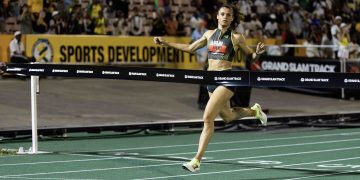At the World Indoors in Birmingham, I asked Adam Johnson-Eder, partner in The Shoe Addicts, the digital partner of RunBlogRun, to make some observations on the access for media at the World Indoors.
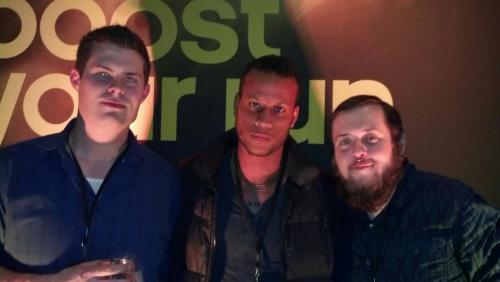 Mike Deering, Algernon Felice, Jr., Adam Johnson-Eder, aka The Shoe Addicts
Mike Deering, Algernon Felice, Jr., Adam Johnson-Eder, aka The Shoe Addicts
Adam has been around the sport and events since he was six weeks old. As a youngster, he was on the track most afternoons with me as I coached at Foothill Community College. Adam also endured his mother and I as we worked on American Atheltics and American Track & Field, trying to keep the publications alive.
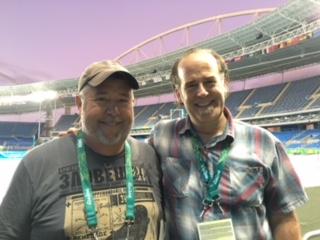 Larry Eder and Brian Eder, RunBlogRun. photo by Victah Sailer
Larry Eder and Brian Eder, RunBlogRun. photo by Victah Sailer
My brother, Brian Eder and I focus on RunBlogRun and its daily content. Brian convinced me to begin writing RunBlogRun in 2006, after cajoling me for about a year. He was right, as the blog quickly outpaced our print readers that I had developed for two plus decades. RunBlogRun changed the way I viewed and see media for sports in general, and athletics in particular.
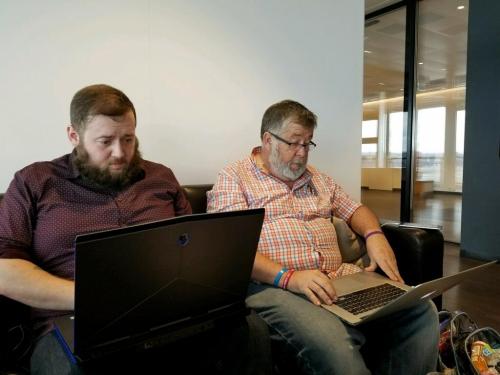 Adam Johnson-Eder, Larry Eder, in airport, a traditional resting place, photo by Mike Deering for The Shoe Addicts
Adam Johnson-Eder, Larry Eder, in airport, a traditional resting place, photo by Mike Deering for The Shoe Addicts
The Shoe Addicts began in 2010, to focus on bespoke video for RunBlogRun and our business clients. Around major events, we have daily video on press conferences, and interviews, and product related videos for our partners. Adam and his partners, Mike Deering and Algernon Felice shoot manage and produce all of our video content.
I asked Adam to concentrate on what things we can do to make the sport more accessible to media. Anyone can offer criticism of our sport, but to truly affect change, one must provide suggestions for the changes that will make the sport better. In the past two months in the US, Runners World was purchased by Heart magazines, Track & Field News has gone completely digital, and the Competitor group and Motiv running sites have been reduced to bit players in the running media.
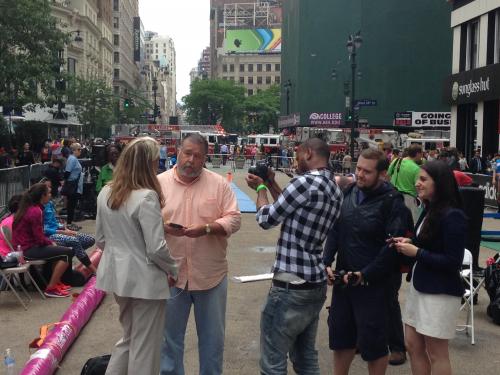 RunBlogRun and The Shoe Addicts in the Big Apple, photo by Mike Deering for The Shoe Addicts
RunBlogRun and The Shoe Addicts in the Big Apple, photo by Mike Deering for The Shoe Addicts
The battle to keep media sites in athletics alive is constant. Media, athletes, managers, sponsors and federations are all invested in making athletics more accessible.
Please send us your comments to runblogrun@gmail.com
Welcome to the Birmingham World Indoors! I hope you brought a coat, because the weather outside is a bit brisk, as are some of my takes on the event as a whole. This is the second world indoors I have attended, and I must say that the event organization is superb, the only thing I saw as a bit of a hurdle for the sport to overcome is a lack of journalists in attendance.
This is for a few reasons:
1. Price– Travel is expensive, and journalism is becoming more difficult financially on a daily basis. Convincing your publisher to lock down down the travel and hotel costs for an event like the World Indoors is far more difficult than, say, a World Outdoors or Olympics. The press area often has coffee and water, which is excellent, but providing some form of a comped meal each session would go a long way in helping to mitigate the travel costs of attendance for photographers, videographers and written press.
2. “Freemium” coverage- excluding the cost of travel and stay, if you possess a camera, you will be asked for the same information for every event, determining whether an IAAF partner can squeeze money out of you for video rights to cover a world event that rarely nears max capacity. No world champs or Indoors I have ever attended has had full stands, which is for a large number of reasons, but that is another article for another time. This is about as short sighted as local sport blackouts in the States.
For an American press member to attend an athletics event in Europe, you are talking upwards of three grand ($3000 U.S., 2,423 Euros/ 2,120 Sterling) at a minimum to attend the event. While I love attending the events, I wonder if love of the sport crosses corporate sponsors minds. When the outlets that disseminate athletic narratives are getting hustled, squeezed, and harassed at every opportunity by Agencies, even while we as media outlets expand the coverage of the sport with no help from said agencies whatsoever. In retrospect, it is quite clear why it was this way in the past, Pappa Diack and his son were cancerous to athletics as a whole, while many athletes struggled to make ends meet, let alone see the sport itself expand.
3. Structural issues– part of the struggle in coverage at events falls on scheduling. Press access to athletes is haphazard, not due to the event being poorly planned necessarily, but because of the constant flow of an athletic event. Something is always going on on the field, is always running down to the mixed zone to try and catch an athlete worth it? Not in the early heats, because athletes head straight through most of the time, saving their energy and focus for the next heat.
I would love to see more opening heats on the first day of these events, with some of the middle distances, so that days two, three and four could be flexible enough to spread finals out in both daily sessions, allowing the athletes and the press an opportunity to maximize their exposure for social media content development. Athletes need every source of revenue to survive, much like the press, and denying them the opportunity to cultivate their own content through the press only hurts name recognition, and ultimately, ticket sales.
4. Press conferences- These often begin during the finals of other events, if you are the one reporter sent by your publication, you will have multiple events and athletes to cover, making the juggling muchmore difficult. This new system being tried out at Birmingham is interesting (Izone), but I’m not sure what the point is of having to request the attendance of the finalists ahead of time. If you pick the wrong athletes before the event finishes and still want to speak with them about the event, you are quite possibly out of luck, as I found out on day one, and the finalists aren’t automatically brought up when there is a cluster of finals back to back, due to timing. Thankfully, they were for the first and second nights, but I think that may have to do the the superb staff in attendance rather than policy.
5. Scaling press windows to events- This ad-hoc style may work at a world indoors, where journalists are in lower attendance, but it would be a terrible idea to do this at a World Outdoor Championships. The ambient sound of dozens of interviews going on at the same time would seriously impact the quality of interview content, not to mention that next to how nature abhors a vacuum, a mixed zone style post event conference is second on the list. People liberally use elbows and block in the mixed zone as much as on the track during select finals, and I can only imagine how terrible this system would have been in London with Usain Bolt’s final conference.
That being said, I do think this system could be great for smaller events, and allow press to get out of the stadium a bit earlier, and it would be a great way to set up federation-based press conferences before the events begin.
6. Additional availability- For a sport that seeks to grow and nurture young talent for future championships, we, as sports journalists and fans of athletics, must make it easier to share the stories of athletes, and that includes the athletes that did not make the medal platform, and the ones that made mistakes. The highs and lows of the athletic calendar are what make this sport so compelling, and with a society that consistently rewards only the best of the best, showing future generations of athletes how to handle loss with grace and aplomb is critical to the health of athletics as a whole.
Author

Larry Eder has had a 52-year involvement in the sport of athletics. Larry has experienced the sport as an athlete, coach, magazine publisher, and now, journalist and blogger. His first article, on Don Bowden, America's first sub-4 minute miler, was published in RW in 1983. Larry has published several magazines on athletics, from American Athletics to the U.S. version of Spikes magazine. He currently manages the content and marketing development of the RunningNetwork, The Shoe Addicts, and RunBlogRun. Of RunBlogRun, his daily pilgrimage with the sport, Larry says: "I have to admit, I love traveling to far away meets, writing about the sport I love, and the athletes I respect, for my readers at runblogrun.com, the most of anything I have ever done, except, maybe running itself." Also does some updates for BBC Sports at key events, which he truly enjoys. Theme song: Greg Allman, " I'm no Angel."
View all posts

